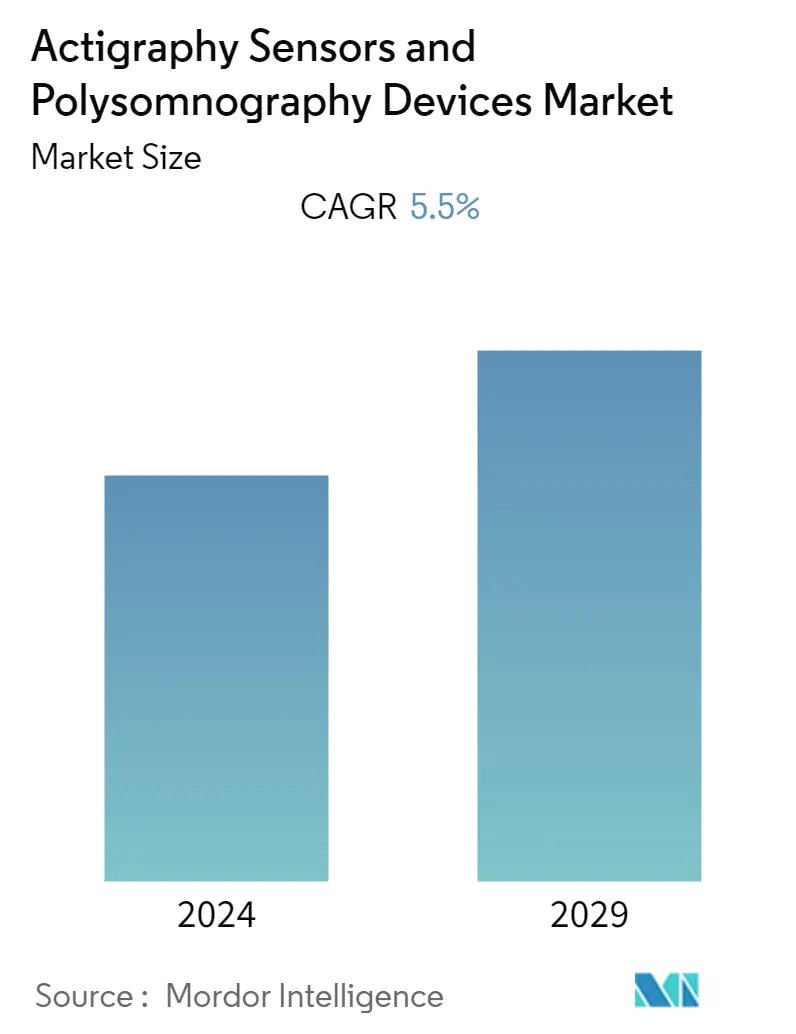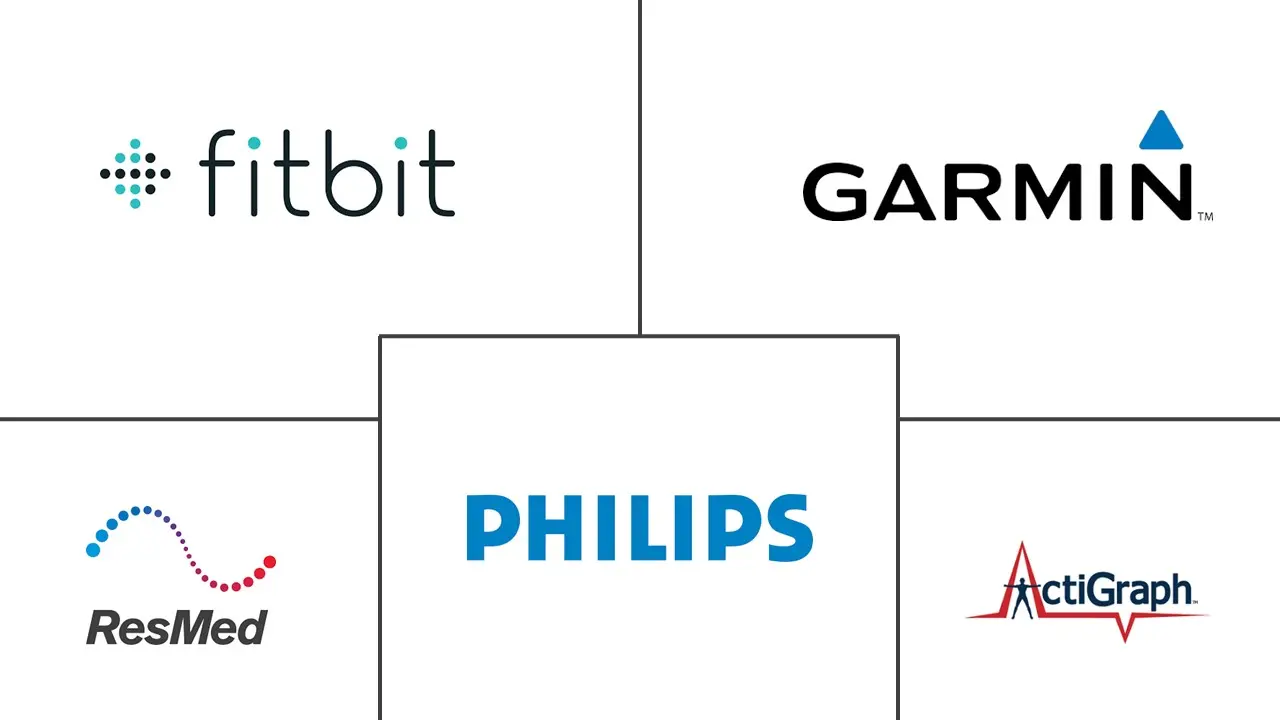Market Size of Actigraphy Sensors and Polysomnography Devices Industry

| Study Period | 2019 - 2029 |
| Base Year For Estimation | 2023 |
| CAGR | 5.50 % |
| Fastest Growing Market | Asia-Pacific |
| Largest Market | North America |
| Market Concentration | Medium |
Major Players
*Disclaimer: Major Players sorted in no particular order |
Actigraphy Sensors & Polysomnography Devices Market Analysis
The actigraphy sensors and polysomnography devices market is expected to register a CAGR of 5.5% over the forecast period.
The COVID-19 pandemic has catalyzed rapid technologic disruption in sleep medicine by accelerating consumer demand for products, including recent care delivery changes, telehealth expansion, remote testing, data monitoring, self-monitoring physiological data using pulse oximeters or EEG sensors in consumer-grade rings, watches, eye or headbands, and other wearables, and AI/ML/DL integrations such as those using heart rate variability (HRV). As telemedicine expands, both physicians and patients are becoming more interested in remote diagnostic and data monitoring technology, including the increased use of disposable home sleep apnea testing devices in the context of the pandemic. For instance, the International Journal of Environmental Research and Public Health published an article in January 2021 where the Valence Aware Dictionary and sEntiment Reasoner (VADER), an AI sentiment analysis tool, was enabled for the examination of tweets from pregnant women and discovered anxiety, depressive symptoms, sleep issues, and anguish connected to isolation during the COVID-19 pandemic. The American Academy of Sleep Medicine (AASM)'s Technology Report published in April 2022 projected a 16.6% growth in end-user spending on wearable wristbands and smartwatch devices worldwide between 2021 and 2022 and a 14.6% rise between 2020 and 2021.
Several factors, such as a rise in the geriatric population, the rising incidence of sleep disorders such as insomnia, restless leg syndrome, sleep-related breathing disorders, and chronic sleep disorders like narcolepsy and hypersomnia, especially among adults, and an increase in the research and development for technological advancements in terms of sleep disease diagnostics and management is projected to drive the growth of the market. Several studies published by the National Library of Medicine in 2021 estimated obstructive sleep apnea (OSA) affects 2-9% of the adult population, restless leg syndrome affects 5-10% of adults and 2-4% of children, and narcolepsy affects between 135,000 and 200,000 people in the United States annually.
As a result, most treatment regimens now incorporate actigraphy sensors and polysomnography devices into their clinical treatment plans. In addition, new product launches and technological advancements by major players in the market are positively affecting the growth of the studied market. For instance, the Nature and Science of Sleep published a research in November 2022 stating that the novel deep-learning technique, OSAnet, could be feasible for the detection and identification of obstructive sleep apnea in home-based devices. The algorithm is based on sleep sounds recorded by a non-contact voice recorder that can be used for the assessment and screening of OSA.
Therefore, owing to the aforementioned factors, such as the adoption of advancing digital technologies, remote sleep technologies, and rising sleep-related disorders coupled with the latest product launches, the studied market is expected to grow significantly during the study period. However, stringent regulatory frameworks and standards associated with manufacturing strategies for actigraphy sensors and polysomnography devices are expected to hinder the growth of the market during the study period.
Actigraphy Sensors & Polysomnography Devices Industry Segmentation
As per the scope of the report, actigraphy sensors and polysomnography are diagnostic tools in the field of sleep medicines. These gadgets are motion-measuring devices that employ small accelerometers to track daily activity, sleep patterns over time, and diagnosis of various sleep disorders such as idiopathic hypersomnia and sleep apnea. The actigraphy sensors and polysomnography devices market is segmented by product type (actigraphy sensors and polysomnography devices), technology type (USB, wireless technology, GPS, and other technology types), distribution channel (hospitals, pharmacies, diagnostic labs, and others), and geography (North America, Europe, Asia-Pacific, Middle East and Africa, and South America). The market report also covers the estimated market sizes and trends for 17 different countries across major regions globally. The report offers the value (in USD million) for the above segments.
| By Product Type | ||||
| ||||
|
| By Technology Type | |
| USB | |
| Wireless Technology | |
| GPS | |
| Others |
| By Distribution Channel | |
| Hospitals | |
| Pharmacies | |
| Diagnostic Laboratories | |
| Others |
| Geography | ||||||||
| ||||||||
| ||||||||
| ||||||||
| ||||||||
|
Actigraphy Sensors and Polysomnography Devices Market Size Summary
The actigraphy sensors and polysomnography devices market is poised for significant growth, driven by advancements in technology and increasing consumer demand for sleep medicine solutions. The COVID-19 pandemic has accelerated the adoption of telehealth and remote monitoring technologies, including wearable devices that track physiological data such as heart rate variability. This shift has heightened interest in remote diagnostic tools, including home sleep apnea testing devices. The market is further bolstered by a rising geriatric population and the growing prevalence of sleep disorders like insomnia and sleep-related breathing disorders. Technological innovations, such as AI and machine learning integrations, are enhancing the capabilities of these devices, making them more effective for diagnosing and managing sleep disorders. However, the market's growth may be tempered by stringent regulatory standards governing the manufacturing of these devices.
The market is expected to be dominated by wireless technology, which offers user-friendly, real-time results and highly sensitive testing capabilities. The integration of next-generation technologies by manufacturers is enhancing the accuracy and reliability of actigraphy sensors and polysomnography devices. The North American region is anticipated to hold a significant market share due to its aging population, high prevalence of chronic sleep disorders, and the presence of established research institutions. The demand for these devices is further fueled by the increasing life expectancy and the need for effective sleep disorder evaluations. The market is moderately consolidated, with major players like ActiGraph LLC, Fitbit Inc., and Koninklijke Philips NV leading the way. Recent product launches and regulatory approvals, such as the FDA's clearance of new devices, are expected to drive market growth in the coming years.
Actigraphy Sensors and Polysomnography Devices Market Size - Table of Contents
-
1. MARKET DYNAMICS
-
1.1 Market Overview
-
1.2 Market Drivers
-
1.2.1 Rising Prevalence of Chronic Diseases and Neurological Disorders
-
1.2.2 Rise in Demand for Insomnia Treatment and Growing Investments
-
1.2.3 Emergence of Advanced Technologies to Increase Accessibility of Smart Actigraphy Sensor and PSG Devices
-
-
1.3 Market Restraints
-
1.3.1 Standards and Stringent Regulatory Framework for Manufacturing Strategies
-
-
1.4 Industry Attractiveness - Porter's Five Force Analysis
-
1.4.1 Threat of New Entrants
-
1.4.2 Bargaining Power of Buyers/Consumers
-
1.4.3 Bargaining Power of Suppliers
-
1.4.4 Threat of Substitute Products
-
1.4.5 Intensity of Competitive Rivalry
-
-
-
2. MARKET SEGMENTATION (Market Size by Value - USD million)
-
2.1 By Product Type
-
2.1.1 Actigraphy Sensors
-
2.1.1.1 Wrist and Handband Actigraphy Products
-
2.1.1.2 Wearable Actigraphy Products
-
-
2.1.2 Polysomnography Devices
-
2.1.2.1 Fixed Polysomnography Products
-
2.1.2.2 Portable Polysomnography Products
-
-
-
2.2 By Technology Type
-
2.2.1 USB
-
2.2.2 Wireless Technology
-
2.2.3 GPS
-
2.2.4 Others
-
-
2.3 By Distribution Channel
-
2.3.1 Hospitals
-
2.3.2 Pharmacies
-
2.3.3 Diagnostic Laboratories
-
2.3.4 Others
-
-
2.4 Geography
-
2.4.1 North America
-
2.4.1.1 United States
-
2.4.1.2 Canada
-
2.4.1.3 Mexico
-
-
2.4.2 Europe
-
2.4.2.1 Germany
-
2.4.2.2 United Kingdom
-
2.4.2.3 France
-
2.4.2.4 Italy
-
2.4.2.5 Spain
-
2.4.2.6 Rest of Europe
-
-
2.4.3 Asia-Pacific
-
2.4.3.1 China
-
2.4.3.2 Japan
-
2.4.3.3 India
-
2.4.3.4 Australia
-
2.4.3.5 South Korea
-
2.4.3.6 Rest of Asia-Pacific
-
-
2.4.4 Middle East and Africa
-
2.4.4.1 GCC
-
2.4.4.2 South Africa
-
2.4.4.3 Rest of Middle East and Africa
-
-
2.4.5 South America
-
2.4.5.1 Brazil
-
2.4.5.2 Argentina
-
2.4.5.3 Rest of South America
-
-
-
Actigraphy Sensors and Polysomnography Devices Market Size FAQs
What is the current Actigraphy Sensors and Polysomnography Devices Market size?
The Actigraphy Sensors and Polysomnography Devices Market is projected to register a CAGR of 5.5% during the forecast period (2024-2029)
Who are the key players in Actigraphy Sensors and Polysomnography Devices Market?
ActiGraph LLC, Fitbit LLC, Garmin Ltd., Koninklijke Philips N.V. and ResMed Inc. are the major companies operating in the Actigraphy Sensors and Polysomnography Devices Market.

